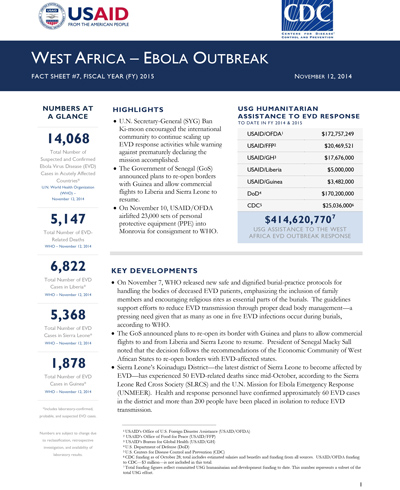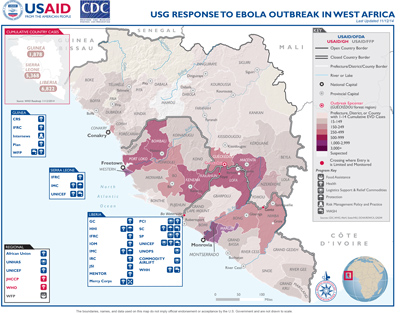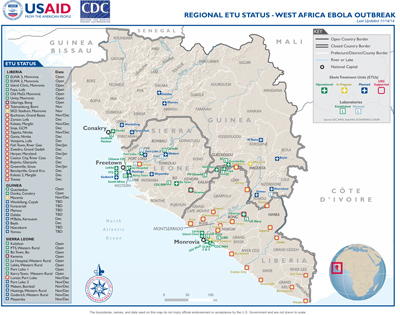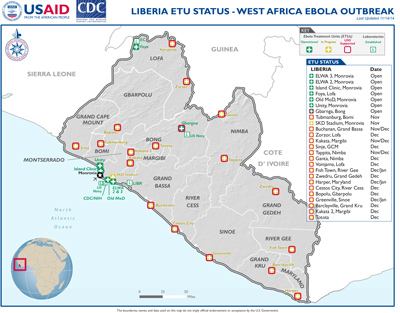November 12, 2014
HIGHLIGHTS
Ebola Response
Visit our main West Africa Ebola Outbreak page to learn more about how we're responding to the West Africa Ebola outbreak, and what you can do to help.
- U.N. Secretary-General (SYG) Ban Ki-moon encouraged the international community to continue scaling up EVD response activities while warning against prematurely declaring the mission accomplished.
- The Government of Senegal (GoS) announced plans to re-open borders with Guinea and allow commercial flights to Liberia and Sierra Leone to resume.
- On November 10, USAID/OFDA airlifted 23,000 sets of personal protective equipment (PPE) into Monrovia for consignment to WHO.
West Africa - Ebola Outbreak - Fact Sheet #7 (FY 15) ![]() (pdf - 275k)
(pdf - 275k)
KEY DEVELOPMENTS
- On November 7, WHO released new safe and dignified burial-practice protocols for handling the bodies of deceased EVD patients, emphasizing the inclusion of family members and encouraging religious rites as essential parts of the burials. The guidelines support efforts to reduce EVD transmission through proper dead body management—a pressing need given that as many as one in five EVD infections occur during burials, according to WHO.
- The GoS announced plans to re-open its border with Guinea and plans to allow commercial flights to and from Liberia and Sierra Leone to resume. President of Senegal Macky Sall noted that the decision follows the recommendations of the Economic Community of West African States to re-open borders with EVD-affected states.
- Sierra Leone’s Koinadugu District—the latest district of Sierra Leone to become affected by EVD—has experienced 50 EVD-related deaths since mid-October, according to the Sierra Leone Red Cross Society (SLRCS) and the U.N. Mission for Ebola Emergency Response (UNMEER). Health and response personnel have confirmed approximately 60 EVD cases in the district and more than 200 people have been placed in isolation to reduce EVD transmission.
CURRENT SITUATION
Amid recent signs of progress in West Africa, SYG Ban Ki-moon warned against prematurely declaring the mission accomplished. SYG Ban noted that the outbreak can be contained through a resolute and coordinated response effort, underscoring that the international strategy of combating EVD through safe burials, treatment facilities, and community mobilization has proved effective in reducing EVD transmission. However, the SYG stressed that response efforts must continue to scale up to bring an end to the EVD outbreak.
Liberia
On November 5, Government of Liberia (GoL) President Ellen Johnson Sirleaf, U.S. Ambassador to Liberia Deborah R. Malac, Joint Force Command Commander Major General Gary Volesky, and members of the USG Disaster Assistance Response Team (DART) attended the official opening of the 25-bed, U.S. Department of Defense (DoD)-constructed Monrovia Medical Unit (MMU). A 70-person U.S. Public Health Service (USPHS) Commissioned Corps team is trained and equipped to care for local and international health staff that contract EVD while responding to the outbreak in Liberia.
As of November 6, the recently opened old Ministry of Defense (MoD) EVD treatment unit (ETU) in Monrovia had admitted three patients, according to the GoL. Cuban and African Union (AU) medical teams, in coordination with the GoL Ministry of Health and Social Welfare (MoHSW), are managing an initial 10 beds, with the capacity to expand to 100 beds if necessary.
The GoL is scaling up active EVD surveillance at the community and individual levels to reduce EVD transmission throughout the country. As part of its EVD response strategy, the GoL plans to train and deploy teams of active case finders to all 15 counties in Liberia in the coming weeks. Overall, the GoL and partners aim to position 4,600 active case finders countrywide, placing one person per 25 houses in targeted communities. As of early November, nearly 1,300 case finders were active in Monrovia alone.
Following an initial CDC, eHealth Africa, and U.N. Children’s Fund (UNICEF) assessment of an EVD hot spot in Grand Cape Mount County on October 29, CDC and eHealth Africa refurbished a building adjacent to a local health clinic to serve as a rapid response triage and isolation center. Staff from eHealth Africa and the county health office plan to train and monitor response center staff and manage operations, while the USG and UNICEF will provide logistical and supply support, including the provision of PPE, medicines, and water, sanitation, and hygiene (WASH) assistance. CDC plans to continue support for contact tracing and case investigation in Grand Cape Mount in the coming weeks, referring EVD cases to the triage and isolation facility.
Based on CDC technical guidance and little evidence indicating that EVD transmission has occurred in schools, the GoL is planning to re-open schools in the coming months—possibly by early 2015. As a precaution, the GoL Ministry of Education has recommended screening students for EVD symptoms—including fever—at schools as they re-open. The GoL continues to develop a plan for re-opening schools that will include a timeline, screening protocols, and guidelines to manage the isolation of probable or suspected cases.
On November 6, DoD, in partnership with the Armed Forces of Liberia, completed construction on an ETU in Bomi County, which the International Organization for Migration (IOM) will manage with USAID/OFDA support. Since late October, the IOM medical team—comprising local and international health care workers (HCWs)—received training on EVD patient care, safety protocols, and ETU management. IOM plans to begin admitting patients to the Bomi ETU in mid-to-late November.
Sierra Leone
On November 5, WHO reported that the number of EVD cases continues to rise in Sierra Leone. UNMEER reports that the outbreak in Sierra Leone is particularly virulent in the western areas around the capital city of Freetown and notes that the number of ETU beds throughout the country needs to scale up significantly by December to reduce EVD transmission. UNMEER also noted that an estimated 50 percent of EVD cases in Sierra Leone go unreported.
On November 6, WHO presented an epidemiology update for Koinadugu District to the National Emergency Response Center (NERC)—the Government of Sierra Leone (GoSL) coordinating body for the national EVD response plan. WHO officials explained that the recent decline in EVD alerts from Koinadugu is a result of limited reporting and response capacity—including insufficient vehicles for transport of suspected EVD cases and delays in securing lab test results—and not a reduction in cases. Koinadugu is among Sierra Leone’s most remote districts, with difficult terrain and limited infrastructure.
In response to the increasing number of EVD cases in Koinadugu, the NERC Operations and Planning Cell met on November 7 and prepared a contingency plan for scaling up the Koinadugu response. The plan includes the establishment of five community care centers (CCCs)—including one already under construction—at sites pre-identified by the Operations and Planning Cell and deployment of additional motorcycles and staff to the district.
A knowledge, attitudes, and practices survey conducted in early November by the Social Mobilization Pillar—the coordinating body for EVD social mobilization activities in Sierra Leone—comprising representatives from the GoSL and relief agencies—identified ongoing misconceptions regarding EVD transmission and response activities. Approximately 34 percent of respondents believed that washing with salt and water kills EVD, and approximately 23 percent of respondents did not accept alternative burial practices that restrict touching or washing of the body. The Social Mobilization Pillar reported that EVD awareness activities—including distribution of behavior change materials, radio messaging, and outreach to civil society and community leaders—aimed at addressing these knowledge gaps are ongoing.
In Bo District, a CDC medical anthropologist conducted a series of focus groups to better understand local knowledge of safe burial practices. Focus group findings included evidence of safe burial practice misconceptions among the majority of participants. Participants also indicated interest in attending the family member burials. CDC anthropologists will use these findings to inform culturally sensitive messaging to reduce community resistance to safe burials in Bo District.
With support from the Government of the U.K. Department for International Development (DFID), the non-governmental organization (NGO) Partners in Health (PiH) plans to take over management of a GoSL ETU—operational since late October—housed at a former SLRCS vocational training center in Port Loko District. Five PiH clinicians from the U.S. are scheduled to begin work at the ETU on November 13. Cuban medical teams will also staff the ETU.
Guinea
On November 7, a representative from the USG DART travelled to Coyah Prefecture with the Grand Imam of Guinea and U.S. Ambassador to Guinea Alexander M. Laskaris to raise community awareness of EVD risks and response efforts. While in Coyah, the Grand Imam conducted a sermon at the central mosque urging congregants to cooperate with health actors and immediately seek treatment if they develop EVD symptoms. The delegation also visited the forthcoming U.N. World Food Program (WFP)-constructed ETU in Wonkifong town, which WFP anticipates could receive patients by late November.
To improve infection control and prevention efforts, UNICEF is equipping up to 600 non-EVD health facilities with disinfectant, hand washing equipment, soap, sprayers, and water supplies. UNICEF also plans to provide WASH assistance at ETUs as needed, and plans to reach 3,000 schools with hand washing and EVD awareness messaging.
As of November 4, USAID/OFDA-supported partner the International Federation of Red Cross and Red Crescent Societies (IFRC) has supported burial teams to conduct more than 1,200 safe burials in Guinea. However, many communities remain concerned that burial practices for EVD fatalities lack dignity and conflict with cultural practices. To garner community support, IFRC burial teams now carry extra PPE and invite family members to attend the burial without handling the body.
Health and humanitarian organizations are establishing village committees—comités de veille (CDVs)—throughout Guinea to create grassroots linkages between social mobilization, contact tracing, and other EVD response activities. According to WHO, community outreach in Guinea is paramount for successfully responding to the EVD outbreak. The response community is currently planning 2,250 CDVs comprising 11,250 members.
USAID/OFDA is supporting NGO Plan International to establish CDVs throughout Guinea, including the establishment of more than 470 CDVs in 50 sub-prefectures of Conakry, N’Zérékoré, Guéckédou, and Coyah.
Mali
Health authorities have quarantined more than 90 people in Mali’s capital city, Bamako, following the death of a nurse confirmed to have contracted EVD, according to international media. Government of Mali and WHO health officials have determined that a man who traveled from Guinea to Bamako for treatment was the source of the disease.
LOGISTICS AND RELIEF COMMODITIES
On November 5, the U.N. Humanitarian Air Service (UNHAS) announced two new helicopter flight routes serving locations in Sierra Leone’s interior. The new service—which will become operational in mid-November—will serve a northern route reaching three locations between Freetown and Koinadugu District’s Kabala town and a southern route targeting four locations between Freetown and Kailahun District’s Kailahun town. UNHAS reports that its helicopters will also be available for ad hoc and special request flights. To date, UNHAS has transported more than 1,700 EVD outbreak responders throughout the region.
On November 10, USAID/OFDA airlifted 23,000 sets of USAID/OFDA-procured PPE—including suits, gloves, goggles, hoods, masks, and other equipment—into Monrovia for consignment to WHO. DART members are facilitating the transport of the PPE to the Logistics Cluster—the coordinating body for humanitarian logistics activities in Liberia, comprising U.N. agencies, NGOs, and other stakeholders—hub in Monrovia prior to onward distribution to health care facilities.
FOOD SECURITY AND LIVELIHOODS
WFP has delivered 17,470 metric tons of food assistance to benefit approximately 1.3 million EVD-affected people in Guinea, Liberia, and Sierra Leone since April 2014. In addition to food assistance, WFP has delivered 38,180 cubic meters of medical cargo in support of EVD response activities in acutely affected countries.
INTERNATIONAL RESPONSE
On November 7, the Government of Japan (GoJ) announced additional assistance of up to $100 million for EVD response activities in acutely affected countries. In addition to supporting the treatment of EVD patients, the GoJ aims to support the reconstruction of national and local health systems in affected countries. The new funding brings the GoJ’s total EVD response assistance to more than $144 million.
The U.N. estimates that 5,000 international medical, training, and support personnel are needed in the three most EVD-affected countries in West Africa, including up to 1,000 international HCWs, on an ongoing basis to treat patients in ETUs. As of November 7, more than 10 countries had deployed nearly 500 medical workers to the region, with pledges to deploy an additional 3,460 to the region in the coming weeks and months.
WFP has received €24 million—more than $29 million—from the Government of the Federal Republic of Germany to support WFP food assistance to EVD-affected areas of West Africa. WFP will initially use the funds to support the purchase of food and an airlift operation to deliver specialized foods to patients at ETUs, recovering EVD survivors, and communities affected by widespread EVD transmission.
PUBLIC DONATION INFORMATION
- The most effective way people can assist relief efforts is by making cash contributions to humanitarian organizations that are conducting relief operations. A list of humanitarian organizations that are accepting cash donations for disaster responses around the world can be found at www.interaction.org.
- USAID encourages cash donations because they allow aid professionals to procure the exact items needed (often in the affected region); reduce the burden on scarce resources (such as transportation routes, staff time, and warehouse space); can be transferred very quickly and without transportation costs; support the economy of the disaster-stricken region; and ensure culturally, dietary, and environmentally appropriate assistance.
More information can be found at:
- The Center for International Disaster Information: www.cidi.org or +1.202.821.1999.
- Information on relief activities of the humanitarian community can be found at www.reliefweb.int.
USAID/OFDA bulletins appear on the USAID website at what-we-











Comment
Make a general inquiry or suggest an improvement.